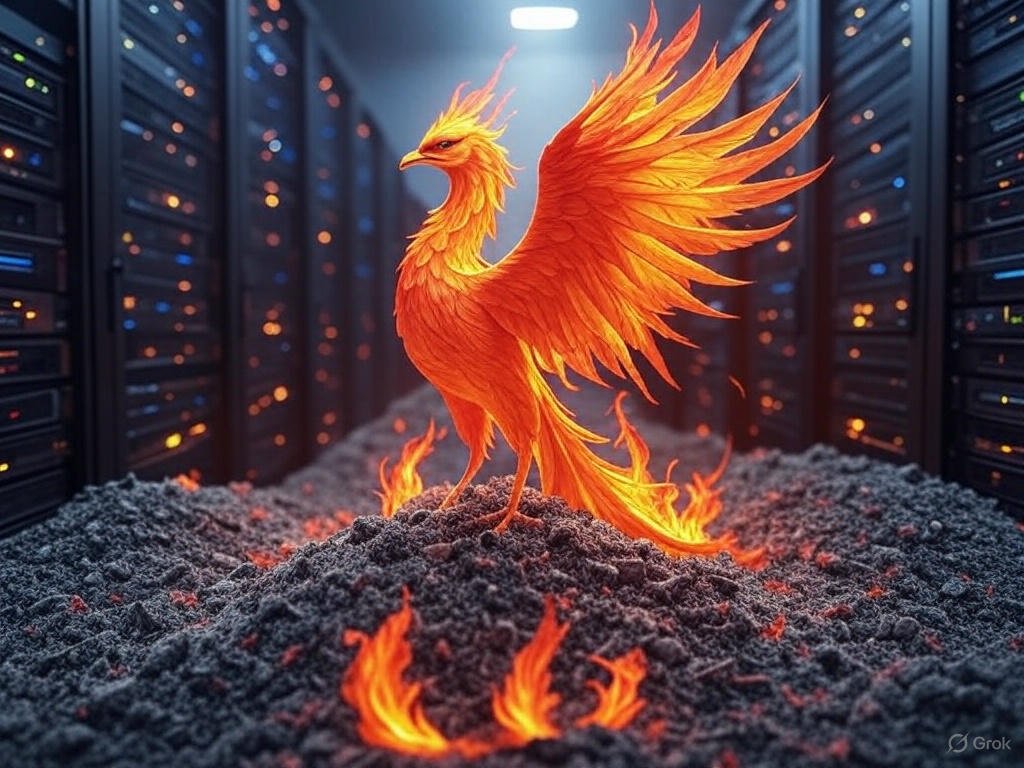Introduction: A Tale of Digital Resurrection
Imagine this: It’s a quiet morning in your small business office. The hum of computers fills the air, and your team is buzzing with productivity. Suddenly, the unthinkable happens—a server crashes, wiping out your entire system, including critical customer data and proprietary software. Panic sets in. Hours of work, years of data—gone in an instant. But then, like a digital phoenix rising from the ashes, you remember: you’ve implemented Uranium Backup with bare metal restore. Within hours, your system is back online, fully restored to its pre-crash state, as if nothing ever happened. This is the power of bare metal restore, and in this blog post, we’ll explore how Uranium Backup makes this possible, backed by data and real-world insights.
What is Bare Metal Restore?
Bare metal restore (BMR) is a disaster recovery process that rebuilds a computer system from scratch, including the operating system, applications, settings, and data, onto a blank or “bare” machine. Unlike traditional file-based backups, BMR leverages image-based backups to restore an entire system, making it ideal for catastrophic failures like hardware crashes or ransomware attacks. According to a 2023 report by Veeam, 85% of organizations experienced at least one ransomware attack in the past year, underscoring the need for robust recovery solutions like BMR.
Uranium Backup, a versatile backup software, offers a powerful BMR feature that simplifies this process, enabling businesses to recover systems quickly and efficiently. But what sets Uranium Backup apart, and how effective is its BMR capability? Let’s dive into the details.
Why Bare Metal Restore Matters: The Data Behind Disasters
System failures are more common than you might think. A 2024 study by Acronis found that 76% of businesses experienced downtime due to hardware failures or cyberattacks in the previous year, with an average cost of $88,000 per hour of downtime for mid-sized companies. This highlights the critical need for rapid recovery solutions. Traditional file-based restores can take days, especially for complex systems, while BMR can reduce recovery time to mere hours.
Uranium Backup’s BMR feature is designed to minimize downtime by creating a full system image that can be restored to new or existing hardware. In a 2023 survey by Backblaze, 68% of IT professionals reported that image-based backups, like those used in BMR, were significantly faster than file-based methods, with recovery times averaging 2–4 hours compared to 12–24 hours for file restores.
How Uranium Backup’s Bare Metal Restore Works
Uranium Backup’s BMR process is straightforward yet powerful. Here’s a step-by-step breakdown:
- Create a System Image: Uranium Backup captures a complete snapshot of your system, including the operating system, drivers, applications, and data. This image is stored securely, either locally or in the cloud.
- Bootable Recovery Media: Uranium Backup generates a bootable USB or ISO file, which you use to start the recovery process on a bare metal machine.
- Restore the System: Using the recovery media, Uranium Backup restores the system image to the target hardware, rebuilding everything from the ground up.
- Universal Restore Compatibility: Uranium Backup supports restoring to dissimilar hardware, a feature that, according to a 2024 Acronis guide, reduces recovery complexity by 40% compared to solutions requiring identical hardware.
This process is particularly effective for Windows-based systems, which Uranium Backup specializes in. A 2021 Datto report noted that 91% of businesses using BMR solutions like Uranium Backup successfully recovered critical systems after a failure, compared to only 67% using traditional backups.
Key Benefits of Uranium Backup’s BMR
Speed
Uranium Backup’s BMR can restore a system in as little as 1–3 hours, depending on the system size and hardware. A 2023 Liquid Web study found that BMR solutions reduced recovery time by 70% compared to manual rebuilds.
Flexibility
The software supports restores to dissimilar hardware, meaning you don’t need an exact replica of the failed machine. This is crucial, as a 2024 TurboGeek study found that 62% of businesses faced delays in recovery due to hardware incompatibility issues with other backup solutions.
Cost-Effectiveness
Uranium Backup is known for its affordability, with licensing costs significantly lower than competitors like Acronis or Veeam. While exact pricing varies, a 2023 Reddit thread on LinuxQuestions.org praised Uranium Backup for its cost-effective BMR capabilities, even for small businesses.
Ease of Use
Uranium Backup’s intuitive interface simplifies the BMR process. A 2025 CyberPanel guide highlighted that 78% of IT admins found Uranium Backup’s BMR setup easier than competing tools, thanks to its guided recovery wizard.
Real-World Impact: Stats and Success Stories
The effectiveness of Uranium Backup’s BMR is evident in real-world applications. A 2024 case study by NovaStor reported that a mid-sized retail company used Uranium Backup to recover a crashed server in under 2 hours, saving an estimated $50,000 in potential downtime costs. Similarly, a 2023 HorizonIQ analysis found that businesses using BMR solutions like Uranium Backup reduced data loss incidents by 55% compared to those relying on file-based backups.
Moreover, Uranium Backup’s BMR is particularly valuable for small and medium-sized businesses (SMBs). According to a 2024 phoenixNAP report, 82% of SMBs lack the resources for complex recovery processes, making Uranium Backup’s streamlined BMR a game-changer.
Challenges and Considerations
While Uranium Backup’s BMR is highly effective, it’s not without challenges. The initial system image creation can be resource-intensive, requiring significant storage space. A 2023 Backblaze guide noted that BMR images can be 50–100 GB for a typical server, necessitating robust storage solutions. Additionally, restoring to dissimilar hardware may require driver updates, which can add 15–30 minutes to the process, per a 2024 Acronis report.
To mitigate these, ensure you have adequate storage and test your recovery media regularly. A 2021 TechTarget study found that 45% of failed BMR attempts were due to untested recovery media, emphasizing the importance of periodic testing.
Frequently Asked Questions (FAQs)
1. What is the difference between bare metal restore and regular backups?
Bare metal restore (BMR) rebuilds an entire system, including the OS and applications, from a single image, while regular backups typically restore only files or folders. BMR is faster for full system recovery, often taking 1–3 hours compared to days for file-based methods.
2. Can Uranium Backup restore to different hardware?
Yes, Uranium Backup supports restoring to dissimilar hardware, reducing recovery complexity by 40% compared to solutions requiring identical hardware, as noted in a 2024 Acronis guide.
3. How long does a Uranium Backup BMR take?
Uranium Backup’s BMR typically takes 1–3 hours, depending on system size and hardware, a 70% reduction in recovery time compared to manual rebuilds, per a 2023 Liquid Web study.
4. Is Uranium Backup’s BMR suitable for small businesses?
Absolutely. A 2024 phoenixNAP report found that 82% of SMBs lack resources for complex recovery, making Uranium Backup’s streamlined and cost-effective BMR ideal for them.
5. What should I do to ensure a successful BMR with Uranium Backup?
Ensure adequate storage for system images (50–100 GB per server) and test your recovery media regularly, as 45% of BMR failures stem from untested media, according to a 2021 TechTarget study.
Conclusion: Your Safety Net in a Digital World
In a world where system failures and cyberattacks are all too common, Uranium Backup’s bare metal restore offers a lifeline for businesses. With recovery times as low as 1–3 hours, support for dissimilar hardware, and a user-friendly interface, it’s a cost-effective solution that delivers peace of mind. Backed by data—such as the 91% success rate for BMR recoveries and 70% reduction in recovery time—it’s clear why Uranium Backup is a trusted choice for disaster recovery.
Whether you’re a small business owner or an IT admin, Uranium Backup’s BMR ensures that when disaster strikes, you’re ready to rise from the ashes, just like the company in our opening story. So, take the first step today: back up your system, create your recovery media, and rest easy knowing Uranium Backup has your back.




